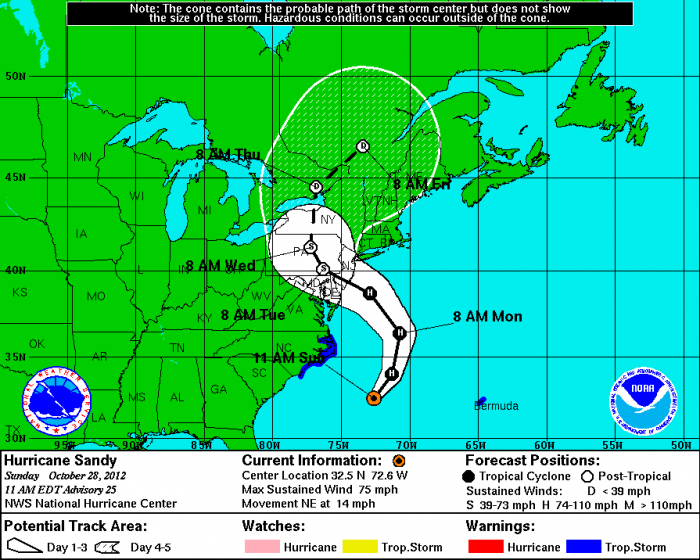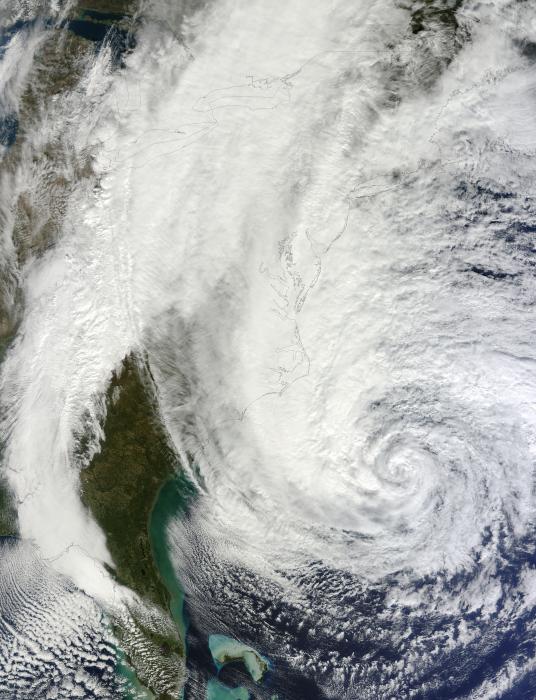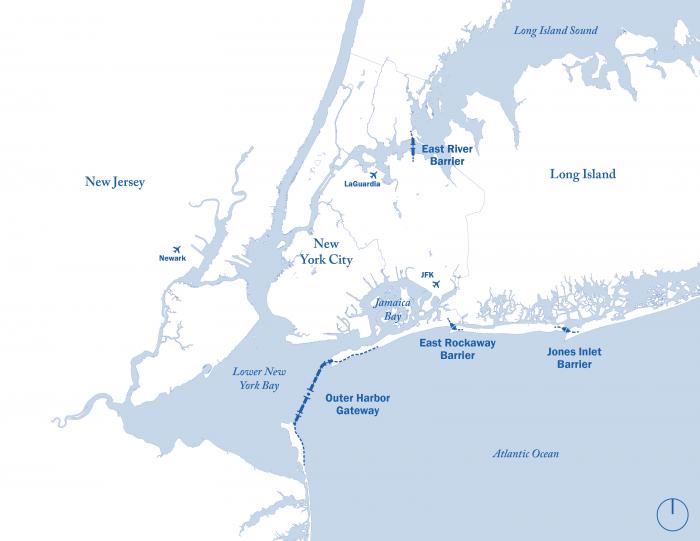Superstorm Sandy: October 2012
Sandy, technically Superstorm Sandy because it merged with another low-pressure system before making landfall in the US, was the largest hurricane ever reported with a diameter of 1400 kilometers (1000 miles)! The storm is known for the damage it inflicted on the New York City region, costing a total of $65 billion. It was notable for two main reasons in addition to its size: first, because it was such a late storm, making landfall on October 29th, 2012, and second because it traveled so far north of typical hurricane country before hitting land.
While a hurricane, Sandy inflicted massive damage in Jamaica, Haiti, the Dominican Republic, and Cuba. In Haiti, the storm was especially destructive and responsible for at least 50 deaths. Sandy had a northerly path and after crossing Cuba and the Bahamas, the storm went out over open waters for several days before taking that dramatic left turn due to its interaction with the low pressure and slamming into the New Jersey coast near Atlantic City.


Coastal communities had plenty of time to prepare. New Jersey forced mass evacuations in low lying areas and New York City closed bridges and tunnels and covered subway openings. Sandy’s winds at landfall were 80 mph with gusts up to 90 mph, but most of the damage was done by the storm surge which measured up to 3 meters (9 feet) in New Jersey and 4 meters (14 feet) in Lower Manhattan. Some areas received a foot of rain. The surge flooded city streets and the subway, including traffic tunnels under the river. Raw sewage was also released into city streets and tunnels. Most of New York City lost power for days. Flooding also occurred along the waterfront on the New Jersey side with devastating flooding in Jersey City and Bayonne. The New Jersey shore bore the brunt of the damage with whole towns ravaged by the storm. Close to 350,000 homes were damaged and 22,000 permanently destroyed. This destruction was largely flooding with wind damage at the shore. Significant beach erosion occurred with on average 9 to 12 meters (30 to 40 feet) of shoreline removed by the storm and Sandy carved new temporary inlets along the shore. Up to a meter (4 feet) of sand was dumped on barrier island streets. Piers collapsed into the ocean. The damage was so extensive in some locations that residents were not allowed back for months. In all, 24 states were impacted by Sandy and there were 71 deaths in nine states. A total of six million people were without power right after the storm. At the time it was the second-costliest hurricane (after Katrina) but has now been surpassed by Harvey and Maria.
Hurricane Sandy
These videos show the damage after Sandy.
Video: Hurricane Sandy: As It Happened (7:40)
Text on the screen: Week One Thursday, Oct. 25. Will Hurricane Sandy Become a Halloween Franekstorm?
Eric Holthaus, WSJ Contributing Meteorologist, Viroqua, Wis. via Skype: This is actually the storm that's gonna be merging with Hurricane Sandy to form the frankenstorm.
Text on the screen: Friday, Oct. 26
Male reporting: Hurricane Sandy hammered the Bahamas early Friday after leaving 21 dead across the Caribbean.
Text on the screen: Hurrican Sandy Kills At Least 20 in Carribbean; On Path For U.S. East Coast
Male reporting: Some are calling it a superstorm, what is that all about?
Eric Holthaus: As this storm moves farther north it will expand. It's just really moving into a question of where.
Text on the screen: Saturday, Oct. 27
Governor Christie: This morning I formally declared a state of emergency in anticipation of Hurricane Sandy. We should not underestimate the impact of the storm and we should not assume the predictions will be wrong.
Mayor Bloomberg: The MTA has announced that they will start shutting down service, the subways starting at 7:00 tonight, buses at 9:00 tonight.
Adam Marcus, Long Island resident: This guy at the beach was saying that all this is all for nothing. Guy says, in 40 years I've lived here nothing has happened. And this could be the one time.
President Obama: Look at it as a serious and big storm.
Governor Christie: If something looks like it's stupid to do, it is stupid. Staying on the barrier islands for 36 hours of hurricane-force winds of 75 miles an hour or more sustained, not gusting, is stupid.
Text on the screen: East Coast Braces for Hurrican Sandy.
Wendy Bounds, Wall Street Journal News Editor: Tens of thousands of people were ordered to evacuate coastal areas on Sunday from Maryland through Connecticut, as hurricane Sandy prepared to make landfall Monday or early Tuesday.
Text on screen: Monday, Oct. 29
Man reporting: There's a shot of Atlantic City, New Jersey this morning as Hurricane Sandy is on her way. Stock and options markets are closed today. Thousands of flights have been canceled. Earnings reports are being delayed and, like I said, Sandy isn't even here yet.
Woman reporting: The East Coast grinding to a halt as Hurricane Sandy prepares to make landfall. What are the major steps you should be doing to protect your home and the belongings from damage from flooding?
Woman responding: Well, everybody should have a go kit and everybody should have a plan as to where they're going to evacuate to and let relatives or friends know where it is that you're going.
Text on screen: Keeping Pets Safe in Hurricane Sandy
Alison Jimenez, ASPCA Senior Media Manager: Just like people were doing, we wanted them to make their preparations early. Start thinking about putting aside some of their pets food, some clean water for their pets for drinking, their pet's medications, their pet's medical records.
Man reporting: Two crew members are missing from the HMS Bounty. It was a tall ship. It has sunk.
Man reporting: Well, that is a live shot of a crane here in New York City.
Text on screen: Crane Dangles from NYC Luxury High-Rise
Man reporting: It has flopped over.
Mayor Bloomberg: This is a massive storm.
President Obama: The most important message that I have for the public right now is please listen to what your state and local officials are saying. When they tell you to evacuate you need to evacuate.
Text on screen: Tuesday, Oct. 30
Woman reporting: The East Coast wheeling this morning as it absorbs the aftermath of superstorm Sandy, where economic damages could be in the range of 10 to 20 billion and at least 30 people have been killed. In seven states, more than eight million homes are without power and in New York City the wounds are particularly severe. In the borough of Queens between 80 to 100 homes caught fire last night and were destroyed. Public transportation, meantime, continues to be closed after extensive flooding. There is no timeline on when that will change.
Governor Christie: The level of devastation at the Jersey Shore is unthinkable.
Liz Heron, WSJ Social Media Director: People did have access to information that was still going on. A lot of people were getting tweets. There's ways you can get tweets without actually having internet or being on Twitter. Because everyone has a smartphone, they're taking a lot of photos.
Woman: Everybody's a reporter now.
Liz Heron: Exactly. Um and you know, there was incredible images being shared.
What are the problems, we're trying to assess damage at this stage?
Josh Mitchell, Dow Jones Newswires Reporter: Well there's two types of damage we're talking about here. One is property damage. So how much damage is there to people's homes, to office buildings, to roads, to the subway system that gets people to work.
Text on screen: Wednesday, Oct. 31
Woman reporting: Millions are still without power as the East Coast struggles to recover from Superstorm Sandy. At least 55 lives have been claimed so far in the U.S. Here in New York, Manhattan is beginning a difficult recovery process, with paralyzed transportation services and power outages. You can just see massive paralysis coming to the city.
Man responding: Yeah certainly. I mean the city's just not set up to have everybody who needs to work here drive in.
Mayor Bloomberg: You have to have three people in the car. Bottom line is the streets can only handle so much.
Male reporting: President Obama and New Jersey Governor Chris Christie surveyed storm damage across the Garden State.
Governor Christie: When all of you look around, you see all this destruction, that's fine. But you know what? All that stuff can be replaced. You look to your right and to your left, to your husband or wife, your son or your daughter. All right, those are things that can't be replaced.
Text on Screen: Thursday, Nov. 1
Woman reporting: Day three of Superstorm Sandy recovery and the death toll has risen to at least 72, nearly half of those in New York City where fires still smolder in Queens and there are reports of looting in Brooklyn and Long Island. Meantime tens of thousands of people in the Northeast are battling traffic, gas lines, limited public transit to return to work this morning.
Simon Constable, Wall Street Journal Columnist: Superstorm Sandy likely delivered insurance companies a twenty billion dollar bill.
Mayor Bloomberg: Recovery is underway and New York is starting to build again. The inspections of the crane on West 57th Street are complete. We plan to reopen public schools for classes on Monday. The MTA really did a phenomenal job of getting subway service partially restored in just a few days.
Text on screen: Friday, Nov. 2
Woman reporting: The governor was just speaking and it looks like some relief is going to be on the way for New Yorkers and people in New Jersey.
Governor Cuomo: Look it's been, it's been a long week. It has been a long week for everyone. It's not over. There are still inconveniences but it could have been a lot, lot worse. And let's not minimize what we went through. You know sometimes we can have a short memory. After the storm we went through on Monday, everything shouldn't be back to normal by Friday. It's going to take time
Video: Most dramatic footage of Superstorm Sandy (3:15)
President Obama: This is a serious storm and it could potentially have fatal consequences.
Governor Christie: We have reports of five feet of water in some places in Atlantic County, significant flooding in Cape May County and in Ocean County. Now everybody thinks they're smarter than we are here, and maybe they are, but not about this.
Male reporting: If you're in your home or somewhere safe where you can remain, stay there.
Woman: Uh oh. Uh oh.
Second Woman: Oh my God!
Third woman: My tree!
Man: We have major complications going up the block. We've also got five buildings, three of them collapsed.
Male Reporter: Stay indoors and certainly away from the parks, the beaches, the boardwalks piers, and sea walls.
Woman Reporter: In Midtown, a crane at the top of a luxury high-rise collapsed and dangled frighteningly in the wind.
Woman: I don't know what's going on (inaudible) What the hell is this? Something just exploded.
Woman: It looks like a doll's house, you know a multi-level dolls house that you're looking into, but it's an actual building
Woman reporting: Toppled trees all around the city, this one blocking a street near Washington Square Park.
Male reporting: For most of the people who stayed off the roads and particularly all of those who got out of Zone A. when we ordered everybody to get out, you made the right decision and we're just going to get through this the way we always do.
Woman reporting: Practically no streets left that makes this point accessible. There are fires burning in the area and for first responders to get there has been completely cut off. We are hoping there are no people still in these homes because there's not much left.
Governor Christie: I didn't expect we would see homes, you know, off of their foundations and in the middle of state highways.
Male reporting: Make no mistake about it, this was a devastating storm - maybe the worst that we have ever experienced. MTA CEO Joe Lhota has described this as the worst disaster the agency has seen in the 108 years the subways have been running. All major airports serving the metro area are closed today. Runways are flooded and there are no flights leaving or arriving.
Governor Christie: We have a long road ahead of us but I have complete confidence we're going to come out of this better and stronger than before. The state is too tough to give in to this type of devastation. And we in the government will be here to work with you to have New Jersey completely recover.
President Obama: Our thoughts and prayers go out to all the families who've lost loved ones. Unfortunately, there have been fatalities as a consequence of Hurricane Sandy. Obviously this is something that is heartbreaking for the entire nation. I want you to cut through red tape. I want you to cut through bureaucracy. There's no excuse for inaction at this point. I want every agency to lean forward and to make sure that we are getting the resources where they're needed as quickly as possible.
There are many lessons from Sandy. The New Jersey coast is one of the most developed shorelines in the world, with a booming real estate market. The shore has been developed since the 1940s, originally with small and simple family cottages. However, over the last 20 years or so, small homes were bought out in many areas, bulldozed, and large luxury mansions were built in their place. The shoreline contains billions of dollars of expensive homes often built too close to the shorefront. As we discuss in Module 10 a lot of the blame for this overdevelopment rests with federal and state governments who resisted passing sensible flood control laws numerous times. This failure resulted in development in areas that flood frequently. The lack of flood control was exacerbated by the National Flood Insurance Program that repeatedly bailed out homeowners, local governments, and the state. The program is supposed to include controls over where rebuilding can take place, but regulation has been loose. Today, NFIP covers 70-100 percent of rebuilding after hurricanes. Environmentalists and others have pushed for much stricter regulation and an end to bailing out homeowners who build in risky locations, but developers and the construction industry have won out (see more detail in Module 10). These failures resulted in homes rebuilt in harm’s way, in some cases multiple times. Environmentalists warned about the devastating impact of a Sandy event for many years and the storm proved them right. However, once again the government paid for everything after Sandy!
Extensive damage in New York City was also a wake-up call. low lying downtown Manhattan and the waterfront on the New Jersey side of the Hudson River contains some of the most coveted real estate in the world and is a global financial center. Sea-level rise over the coming decades will make the area even more vulnerable to storm surge with potentially truly devastating financial implications. For this reason, Sandy inspired renewed discussions about a major investment in flood control that would protect lower Manhattan and the New Jersey waterfront from storm surge in a future Sandy. There has been considerable planning into what this structure might look like with the most extreme cases involving 8 kilometers (5 miles) of concrete and steel surge “gates” extending from New Jersey all the way to Long Island across the harbor and another gate along the west of Long Island Sound. Each structure would involve miles of shore fortification at the ends of the gates. The system would cost in excess of $120 billion.

Read the latest on the proposed system here in this New York Times article: The $119 Billion Sea Wall That Could Defend New York … or Not
The final lesson from Sandy is that climate change will cause powerful hurricanes to move further north and extend the season into October. It is still debatable whether Sandy was a result of climate change, though the Atlantic waters were warm unusually late in 2012. The New York metro area and the New Jersey shore have seen their share of powerful hurricanes and Sandy may just have been a late-season anomaly. However, it is certainly reasonable with climate change to expect earlier and later storms and for stronger storms to make landfall further north. The large northeastern “megalopolis” extending from Washington DC to Boston and including Baltimore, Philadelphia, New York City is home to some 50 million people with $3.6 trillion in economic output per year. Sandy likely foreshadowed the future and this region better prepare for the eventuality of more large storms.
